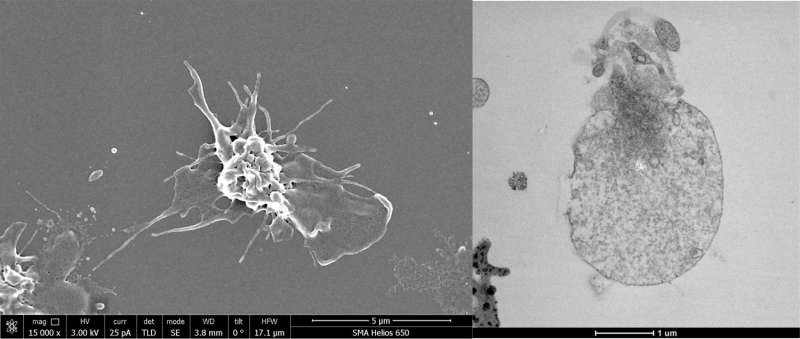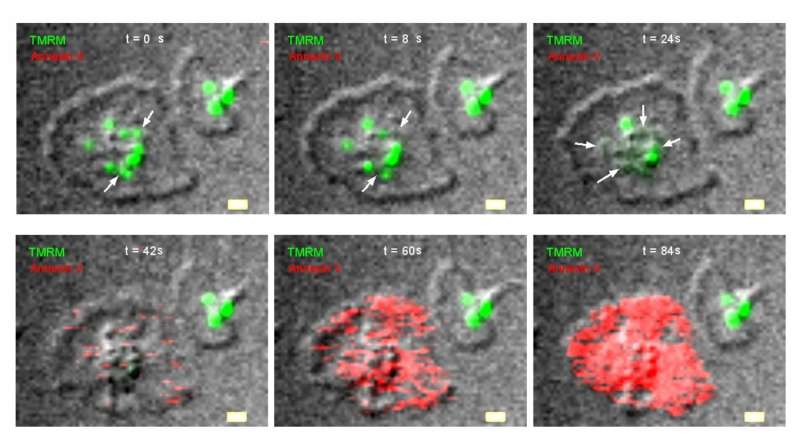Scientists characterize the platelet activation process for coagulation

Platelets are small anucleated blood cells responsible for stopping bleeding. They detect blood vessel damage and agglutinate, creating aggregates and stopping blood loss. This process is called hemostasis. Platelets aggregate and plug the wound upon activation. Scientists regard the platelet as one of the simplest cells in the human body, because the goal of its life is to decide whether activate or not. But despite this relative simplicity, numerous questions remain about the mechanisms of its functioning. Mikhail Panteleev of Lomonosov Moscow State University led a recent platelet activation study and the results are published in the Journal of Thrombosis and Haemostasis.
There are two kinds of activated platelets: "ordinary" platelets (capable of aggregation) and "super-activated" platelets (procoagulant platelets, able to accelerate coagulation). When activated, the aggregating platelets change their shape from discoids to amoeboids, with multiple "legs" (filopodia) that improve interactions and foster spreading across the surface. These platelets form the main body of the platelet thrombus. The super-activated platelets become spherical and enlarged (they are also called 'balloons'). They are able to enhance clots and accelerate the blood clotting reaction. One of the mysteries in the field of hemostasis and thrombosis is how these cells get divided into two populations when activated. What determines a platelet's fate? The team of scientists figured out a crucial puzzle of platelet signaling.
The central player in this decision turned out to be mitochondria. It is believed that mitochondria—organelles present in almost all animal (and plant) cells, including platelets—provide them with energy due to redox reactions.
"But it seems that platelets need mitochondria not only for energy, or even not at all for energy, but for a quick suicide," says Mikhail Panteleev.

Scientists demonstrated how the platelet's programmed death (mitochondrial necrosis) follows a chain of processes leading to the transition of the platelets into the super-activated state. In other words, to become super-activated, a platelet must die. For this reason, platelets are also called "kamikaze cells."
"It was unclear previously how a platelet makes the decision to become a particular type. We have deciphered the sequence of events—how the signal manifests within the platelet, and how the cell decides to die," Mikhail Panteleyev says.
The researchers found that the activation process is as follows: A platelet has many activators, but the chief among them are collagen, ADP and thrombin. Platelets detect different concentrations of an activator, and respond with a varying frequency of the calcium impulses in the cytoplasm. This phenomenon is called calcium oscillation. Platelet mitochondria absorb and store the calcium, and when its concentration exceeds a critical level, the process of mitochondrial necrosis (a rare version of programmed cell death) begins. Calcium and reactive oxygen species are released from the mitochondria, ATPases begin to destroy ATP instead of synthesizing it, the cell cytoskeleton collapses, and the platelet size greatly increases. As a result, a lipid called phosphatidylserine appears at the outer membrane of the enlarged spherical platelet, which is responsible for rapid blood clotting. And all this happens within seconds.
Last year, the same group of researchers published an article about the theoretical mechanism of mitochondrial necrosis in the journal Molecular BioSystems, and in the present paper, this process has been experimentally proven.
Moreover, another article by Mikhail Panteleyev and his colleagues from the Faculty of Physics and Faculty of Fundamental Medicine, MSU, was accepted for publication ("Systems biology insights into the meaning of the platelet's dual-receptor thrombin signaling"). In the report, scientists explain that the same activator influences two receptors in the platelet to achieve maximum sensitivity.
More information: Sergey I. Obydennyy et al, Dynamics of calcium spiking, mitochondrial collapse and phosphatidylserine exposure in platelet subpopulations during activation, Journal of Thrombosis and Haemostasis (2016). DOI: 10.1111/jth.13395

















